


 National Academy of Agricultural Sciences (NAAS)
National Academy of Agricultural Sciences (NAAS)

|
PRINT ISSN : 2319-7692
Online ISSN : 2319-7706 Issues : 12 per year Publisher : Excellent Publishers Email : editorijcmas@gmail.com / submit@ijcmas.com Editor-in-chief: Dr.M.Prakash Index Copernicus ICV 2018: 95.39 NAAS RATING 2020: 5.38 |
The CRISPR/Cas9 system has been used predominantly for precise editing of the plant genomes. In the present study, we have made an application of CRISPR/Cas9 system for targeted mutagenesis in rice(Oryza sativa L.) targeting the Phytochrome and Flowering Time 1 (PFT1) gene known to be involved in disease susceptibility in Arabidopsis for root-infecting hemibiotrophic fungal pathogen Fusarium oxysporum. Hence, to confirm the role of OsPFT1 gene in rice sheath blight disease, CRISPR-Cas9 gene editing tool is being employed for generating OsPFT1 gene knock out in rice. Two guide RNAs (gRNAs) were designed to pair with distinct OsPFT1 gene region followed by protospacer-adjacent motif (PAM). Rice genome editing constructs were cloned and mobilized into the Agrobacterium strain LBA4404. The transgene (Cas9-gRNA) introduction into indica rice variety ASD16was done via Agrobacterium-mediated rice transformation by using immature embryos as explants. The gRNA will direct the Cas9 nuclease to generate double-strand breaks (DSB) at the specific sites of OsPFT1 gene, thereby introducing mutations at the DSB by error-prone non-homologues end joining repair mechanism. Through PCR analysis, the presence of the hpt transgene was identified. Homozygous gene-edited transgenic rice plants will be identified and further will be subjected to sheath blight disease screening.
 |
 |
 |
 |
 |